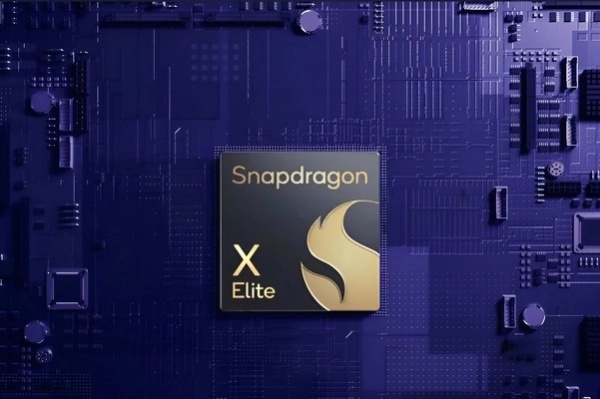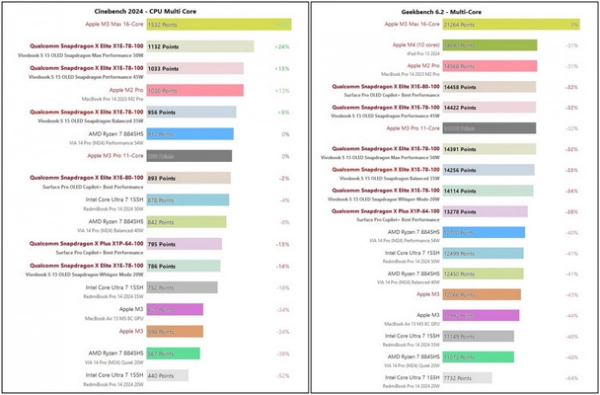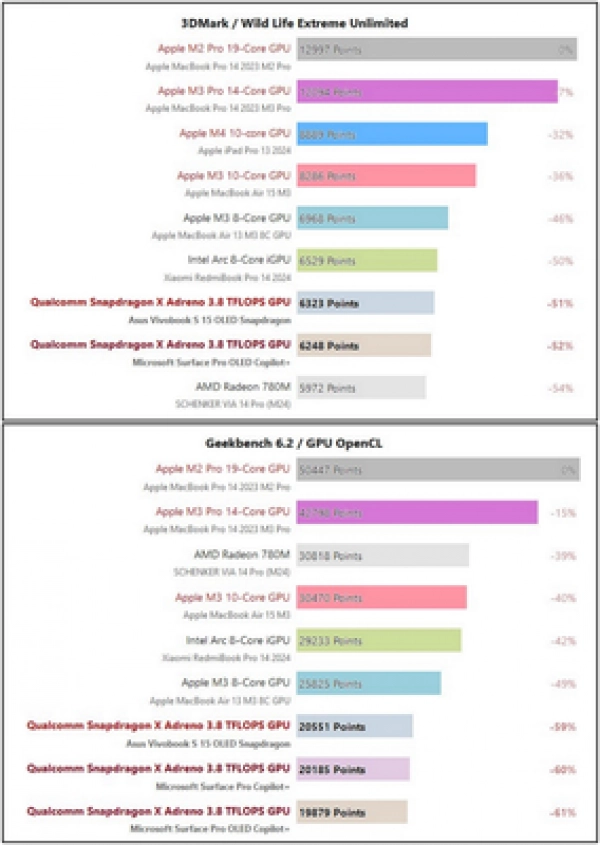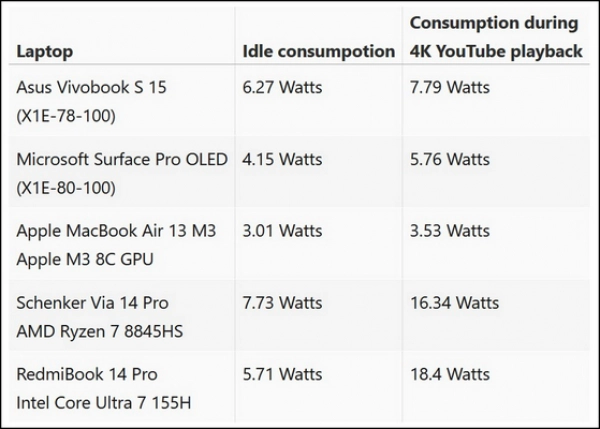Is the Snapdragon X Elite Truly as Powerful as Rumored?
The Snapdragon X Elite, Qualcomm's latest flagship, has officially launched and quickly captured the attention of the tech world. With significant improvements in performance, graphics processing, and energy efficiency, the Snapdragon X Elite is expected to bring a fresh wave to the mobile chip market. But does this chip truly live up to Qualcomm's claims? Let's dive into a detailed performance review of the Snapdragon X Elite.
Overview of Snapdragon X Elite
The Snapdragon X Elite from Qualcomm is a chip series designed to enhance performance and software compatibility for computers, including both laptops and desktops. These chips are manufactured on a 4nm process, with 12 cores and 42MB of cache, supporting ultra-fast LPDDR5x RAM, and come with either 16GB or 32GB of non-upgradable RAM.
The NPU of the Snapdragon X Elite can handle 45 TOPS, meeting Microsoft's requirements for AI Copilot+ computers. Additionally, the chip supports advanced connectivity options like Wi-Fi 7, Bluetooth 5.4, and can integrate a 5G modem.

In terms of performance, the chip's TDP ranges from 15-80W with the ability to boost up to 4.0GHz – 4.3GHz depending on the model. Graphics are handled by the Adreno X1-85 GPU, with high-end versions capable of processing 4.6 TFLOPS and lower-end versions handling 3.8 TFLOPS, sufficient for light gaming.
On the software side, Qualcomm's Snapdragon X Elite supports various applications like Microsoft's Office suite, Adobe software, and popular browsers. However, some applications may encounter issues due to lack of ARM support. Qualcomm offers multiple versions of the Snapdragon X Elite with varying levels of performance and graphics capabilities, catering to a wide range of user needs.
Real-World Performance Evaluation
1. Single-Core Performance Test
To assess the power of Qualcomm's Snapdragon X Elite chip, several users conducted benchmark tests on various laptop models, including the lower-end Snapdragon X Plus, Apple products like the MacBook Air 13 M3, MacBook Pro 14 2023, and several laptops running Intel and AMD CPUs.
In single-core performance tests, Cinebench 2024 results showed that Apple's M2 Pro and M3 chips remained at the top, although the Surface Pro OLED with the Snapdragon chip scored similarly to the M2 Pro.
In Geekbench, Apple's M4 chip demonstrated superior performance in scoring. Regarding performance relative to power consumption, results showed that Apple's M3 and M2 Pro chips continued to lead, while Intel and AMD CPUs scored lower. Notably, the Snapdragon X Plus chip scored higher than the two premium Snapdragon X Elite versions.

2. Multi-Core Performance Test
In multi-core performance tests, Qualcomm's new products, including the Snapdragon X Elite series, achieved very high scores, proving that they are stronger than Apple's M3 chip.
However, Apple might have lost this "round" to Qualcomm due to its chips not being equipped with active cooling fans (as in the MacBook Air), which impacted performance. The real competitors for Snapdragon X Elite in these tests are the M3 Pro and M3 Max chips.
In Cinebench 2024, Qualcomm's chips only needed to run at a TDP of 35W to outperform the Intel Core Ultra 7 155H running at 50W, and they were only slightly outperformed by the Ryzen 7 8845HS when it consumed 54W.
Qualcomm's chips also outpaced Apple's M2 Pro when running at 45W or higher. These results indicate that Qualcomm's chips are more efficient than Intel and AMD chips in multi-core tasks. However, when TDP increases, the performance of Qualcomm's chips shows signs of diminishing, especially from 45W upwards.

3. Graphics Performance
Graphics performance tests, including 3DMark Wild Life Extreme Unlimited, Geekbench, and GFXBench, revealed interesting results about the Snapdragon X Elite's GPU. The final results showed that the Snapdragon X Elite's OpenCL performance lagged behind its direct competitors.
Qualcomm's new Adreno GPU sits between the Radeon 780M and Intel Arc Graphics with 8 Xe cores in 3DMark, but it falls short of Apple's M3 chip and, of course, the M4 and M2 Pro. In two High-Tier tests of GFXBench, Qualcomm's Adreno GPU was slightly faster than the 8-core GPU of Apple's M3.
In terms of power consumption, the Adreno GPU of the Snapdragon X Elite consumes about 12-15W and is considered more efficient than its competitors from AMD or Intel. However, compared to Apple's GPU, the Adreno GPU is noticeably inferior. This is similar to the CPU results, where the Snapdragon X Elite delivers superior performance over AMD and Intel products but still falls short of Apple's offerings.

4. Power Consumption
Tests on power consumption were conducted on laptops in idle mode and while playing full-screen 4K YouTube videos via an external 4K display to avoid influence from different screen sizes and technologies. The results showed that power consumption depends not only on the chip itself (SoC) but also on the manufacturer's optimization.
In idle mode, the Qualcomm Snapdragon X Elite in the Surface Pro OLED Copilot+ was slightly more power-efficient than the Asus Vivobook S 15 OLED. The RedmiBook Pro 14 with Intel Core Ultra 7 155H consumed power between the two Qualcomm chips, while the AMD Ryzen 7 8845HS in the Schenker Via 14 Pro consumed more power. Apple's M3 chip remains the most power-efficient SoC.
When playing videos, the results were similar to idle mode, with laptops running Intel and AMD CPUs consuming significantly more power than those powered by Qualcomm and Apple. This indicates that Qualcomm and Apple's chips are not only performance-efficient but also more power-efficient than their competitors from Intel and AMD.

Key Features
Snapdragon X Elite is Qualcomm's most powerful ARM chip for premium Windows computers and laptops. The chip boasts several standout features, including:
1. Superior Performance
- Custom Qualcomm Oryon CPU: Designed on TSMC's 4nm process, with 12 cores and 64-bit architecture, the chip delivers outstanding single-thread and multi-thread performance compared to other competitors in the same segment.
- Qualcomm Hexagon NPU: Reaching 45 TOPS, it accelerates local AI processing and supports complex AI applications.
- Adreno 740 GPU: Provides impressive graphics performance, meeting the needs of gaming and professional graphics processing.
2. Energy Efficiency
- Low Power Consumption: Thanks to the 4nm process and ARM architecture, the Snapdragon X Elite consumes less power than its competitors, extending the battery life of the device.
- Support for LPDDR5X RAM: With speeds up to 8533Mbps, enhancing multitasking and data processing capabilities.
- Support for Wi-Fi 7: Offering fast and stable wireless connectivity.
- Support for 4K 120Hz Displays: Delivering sharp and smooth visual experiences.
Overall, the Snapdragon X Elite is an impressive chip, marking a significant leap for Qualcomm in the mobile chip race. With powerful performance, good energy efficiency, and many attractive features, the Snapdragon X Elite promises to deliver great experiences for users on premium mobile devices.
Submit feedback
Your email address will not be made public. Fields marked are required *
Search
Trend
-
What is Black Myth: Wukong? Detailed Guide on System Requirements and Gameplay
08-21-2024 . 1k view
-
The simplest and fastest way to log into the Chinese TikTok, Douyin.
01-10-2022 . 1k view
-
Blog sites that will accept AI generated content
07-26-2024 . 1k view
-
Call of Duty: Black Ops 6 - Intense, Mysterious, and Surprising Warfare
09-02-2024 . 1k view
-
The "End of Life" for Windows 10: A Massive E-Waste Threat and Sustainable Solutions
08-18-2024 . 964 view










0 feedback